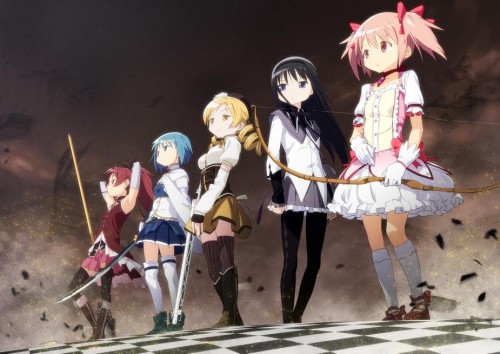
This guest post by Kathryn Diaz appears as part of our theme week on Children’s Television.
Imagine a world where young girls are trapped in a system that sees them as commodities. Imagine that any girl could be tricked into giving herself up to a life that is by all appearances filled with magic, beauty, excitement, and good, but exists to feed off the energy of their spirit. The girls are purposely pushed to their limits. When they have become too cynical or burdened, the system condemns them and sends in younger counterparts to pick them off. Imagine that these girls are pitted against each other, that once they have been lured in with heroic, fairy tale trappings, they are encouraged to turn around and use the power that they should be grateful for to use and destroy each other. At the top of this system sits a small white creature. He just can’t understand why girls get so upset when they learn the facts of life they signed up for.
…..That wasn’t very hard to imagine after all, was it?
The world of Gen Urobuchi and Alex Von David’s 12-episode anime Puella Magi Madoka Magica (PMMM from here on out) is a bleak one, and the frills of magic and a futuristic backdrop don’t make it any less recognizable. Girls of a certain age are propositioned by manipulative bastard Kyubey to make a contract with him. One wish, one miracle, and they can become beautiful guardians of justice. It’s the kind of rhetoric that sits next door to “any girl can be a princess” and “you can make your dreams come true if you just believe.” And yes, it’s a trap.
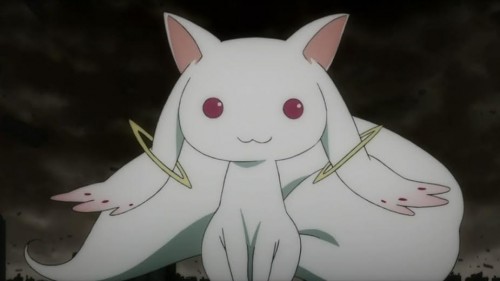
The Magical Girls can’t use up too much of their magic, or else their soul gem becomes dirty. To keep the gem “pure,” the girls must earn grief seeds by annihilating witches. Sometimes this means letting a Witch get away with murder until it’s nice and big. Sometimes this means killing another girl for ownership of the seed. That’s just how it is. Don’t whine about hurting other girls, don’t you know they’re after you too? Don’t you want to do the smart thing? In Kyubey’s Magical Girl system–you perish as a girl or suffer long enough to turn into a Witch. That’s right. The Witches are the Magical Girls that couldn’t keep their gems pure enough and lost hope. But don’t expect Kyubey to say that before he orders you to defeat them.
What keeps PMMM from being more than just a grim tableau of systemized manipulation and elevates it into bona-fide feminist fairy tale territory is the girls that populate the landscape and the lengths they go to help each other. Meet Mami, Sayaka, Kyoko, Homura, and Madoka.
Mami Tomoe is the team mom. She comes onto the scene to the tune of her own theme song and invites Madoka and Sayaka over for tea and snacks after rescuing them from a Witch. Mami is the advice giver, the protector, the good example big sister. “It’s a really hard decision, isn’t it?” She says about Kyubey’s contract. “There’s no reason to rush into it.” Ever assertive, Kyubey interrupts, “Though for me, the sooner you decide, the better.” Mami dismisses him with a laugh, “Nobody likes a boy who pressures girls to do things.”
Sayaka Miki is the black-and-white idealist. She shuffles events, facts, and people into good or bad categories as quickly as she cracks jokes or shrugs off her angst. Sayaka is the one who realizes that she and Madoka can’t think of any good wishes because they’ve lived such sheltered lives and wonders why it’s so unfair. When being a Magical Girl doesn’t turn out the way she wanted, Sayaka resolves to keep fighting. “I’m going to be a different kind of Magical Girl from all of you,” she says. “I’ll be the only Magical Girl who won’t use her magic for herself.”
Kyoko Sakura plays a tough game. She’s a loner, and doesn’t have too many qualms with eliminating other girls or letting go of small prey. “The weak have to give way to the strong,” she says. But underneath her talk, Kyoko has a heart as sensitive as Sayaka’s, and her outlook on life has been earned just as bitterly as any other experienced girl’s. In the end, Kyoko can’t abandon a Magical Girl she identifies with, and proves that she’s as loyal as she is fierce.
Homura Akemi is a woman on a mission, and nothing and no one can stop her. Although we learn that Homura was once a timid girl, the young woman who races against time to stop Kyubey and save Madoka is anything but. Her aloof demeanor is her armor, and her determination is her greatest weapon. The core of Homura’s motive is love. Since she first became a magical girl, Homura has carried a devoted, undying love in her heart. “It’s the only thing I have left to guide me,” she confesses quietly.
Madoka Kaname spends most of the series as “the best friend” of the Magical Girls. She follows her friends on their hunts so they won’t be alone, crying, “This just can’t be right!” from the sidelines. She is a true comforter and supporter of the girls. It’s her hope from the time she’s rescued by Mami to the very end that Magical Girls stand with each other in spite of their differences and support one another.
As mentioned earlier, all these girls, in one way or another, eventually try to help each other in massive ways. These actions in all the forms they take are based in communicating experiences and developing empathy. Not only do these actions form the crux of the Magical Girls’ character arcs, but they serve as the major plot points of the larger PMMM plot. Let’s say that again: the most important events in this story are girls looking out for girls in a system where they are explicitly not supposed to.
Mami begins the story as Ms. Helpful, but her self-imposed responsibility for Madoka and Sayaka extends beyond showing them the ropes. Mami wants to give them what she never had: the right to an informed, carefully weighed choice. Mami tells Madoka and Sayaka about the lore of Magical Girls to make sure they’ll fully understand the tradition they’ll be becoming a part of. “You have the rare chance to have any wish granted, but remember that wish lies side-by-side with death.” She doesn’t bother with subtlety or ominous words. Life is too short for that, and her junior Magical Girls deserve better. Mami’s most meaningful reveal to the girls, however, is not in lore or an anecdote, but in her very personal feelings. “I only push myself and pretend to be cool,” she tells Madoka. “When I’m scared or hurting, there’s no one I can talk to. All I can do is cry on my own.” Madoka understands, or at least she does her best. She asks to be the person Mami needs and be her Magical Girl partner in justice. Madoka and Mami’s friendship is cemented through sharing and empathy. This has such a profound impact on Mami that she races and twirls through her next fight, overjoyed. “I’m not afraid of anything anymore,” she says. “Because I’m not alone anymore!”
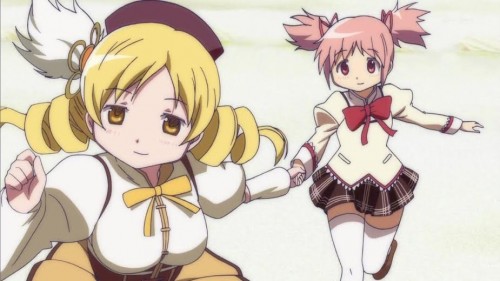
The other profound heart-to-heart in PMMM is between Kyoko and Sayaka. When Sayaka takes the truth about Kyubey’s Magical Girl system particularly hard, Kyoko’s remedy is to take her out for some air and show Sayaka why her self-serving approach to life isn’t so bad after all. “If you only live for yourself, you only have your own mistakes to pay for,” Kyoko says. She didn’t always think that way, but when her selfless wish lead to the deaths of her whole family, she reconsidered. Kyoko’s tragic history doesn’t change Sayaka’s mind about being a selfless Magical Girl, but it does wash away the violent animosity between them and establish a deep understanding based on empathy. From this moment on, the two girls are bonded. Sayaka speaks candidly with Kyoko about her mounting disenchantment and grief. Kyoko comes to care for Sayaka enough to stay beside her even after she turns into a Witch. Because of how they’ve connected, Kyoko understands the kind of pain festering in Sayaka’s Witch. Since she cannot change her back, Kyoko decides to sacrifice her life to end Sayaka’s Witch, staying beside her to the very end and saving the rest of the Magical Girls.
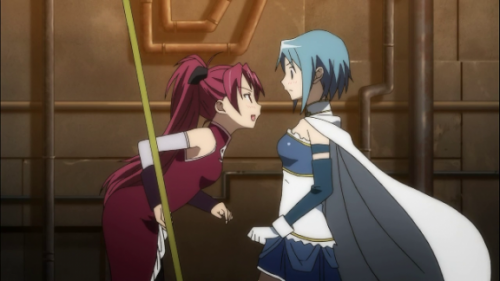
Homura, as it turns out, has been using her time manipulation powers to try and save Madoka from Kyubey. Over. And over. And Over. The more she tries, the more ruthless her determination becomes. Homura gives up all other hopes and aspirations for one impossible task. “It’s the only thing I have left to guide me,” she admits quietly. Why? Because Madoka was kind to her. She showed her friendship and love, and Homura can’t bear the thought of the world losing her forever. The story embraces this devotion when the reason behind Madoka’s exceptional magic potential is revealed. Every timeline Homura negated to save Madoka is stacked inside of her. Every time Homura decided not to give up, every time Homura let a piece of herself go so she could keep trying is nested in Madoka’s soul, and it has only made her stronger.
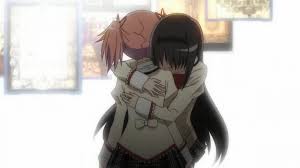
To repay Homura and save everyone she has ever loved, Madoka gets out from the sidelines and puts the strength Homura’s love has given her to good use. It turns out there is something in the world worth becoming a magical girl for: “I wish to erase all Witches before they are born. All the witches in all the universes, both past and future, with my own hands! All those who fought against Witches, who believed in hope as Magical Girls–I don’t want to see them cry. If any rule or law stands in the way of that…I will destroy it. I will rewrite it.”
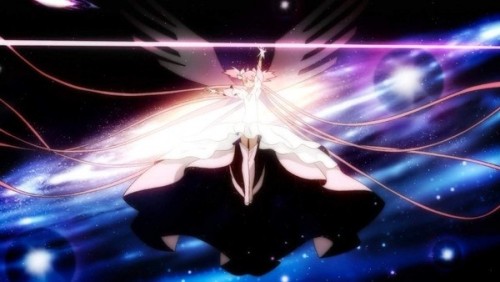
That’s right. Madoka uses her wish to undo Kyubey’s system and ease the suffering of every Magical Girl there ever was and will be. No more systemized destruction between girls for Kyubey’s benefit. No more exploitation of girls’ hope. No more fighting Witches. Madoka takes the idea of ‘wish fulfillment fantasy’ to a spectacular new level, but I did say this story was a fairy tale, remember? As Madoka’s wish comes true, we see her visit girls in ancient civilizations, in war-ravaged countries, girls of color, girls with different languages, with different cultures and beliefs. She touches their soul gem to take the despair away and shares a moment of understanding with them. When they close their eyes they die, smiling.
This montage matters not just so we can cry into our laptops at the impossible beauty of a little girl willing a kinder world into existence, but so that we know Madoka has not invented world peace. The world still has curses. Life is still imperfect and girls still suffer and die young. Madoka isn’t even Madoka anymore. Standing with every Magical Girl at once means becoming primordial force in the universe, unseen and unknown to those that aren’t Magical Girls. What is achieved is fundamental comfort, peace, and hope. “You aren’t just giving us hope,” Mami says. “You’re becoming hope itself. The hope for us all.” Because Madoka has been a source of comfort and empathy from the beginning, this means that “the hope for us all” starts with reaching out to fellow girls and women across barriers. This means that standing with girls against forces that would have you tear each other apart can help change the world. Not too fantastical after all, huh?
Like all good fairy tales, PMMM sweetens all the tragedy that came before and wraps its rich symbolism in a neat bow. At the end, tucks you in bed with a moral to give sweet dreams:
“Don’t forget, always, somewhere, someone is fighting for you. As long as you remember her, you are not alone.”
And, you know, there’s always room to be that kind of Magical Girl too.
Kathryn Diaz is a writer living in Houston, Texas. You can follow her at The Telescope for more of her work.
This is a really good essay on Puella Magi Madoka Magica, but it’s kind of strange to see it in a theme week on “children’s television” when Madoka is NOT a children’s show. It’s listed on Wikipedia as seinen, which means it’s primarily aimed at adult men: https://en.wikipedia.org/wiki/Puella_Magi_Madoka_Magica On top of that, it’s quite violent and dark, and not what most people on either side of the Pacific would consider appropriate for pre-adolescent kids.
Not all anime is for children anymore than all American animation is; just as we have Family Guy and South Park, they have cartoons for adults, too. And I’d think that would be a stereotype of which a film blog of Bitch Flicks’ caliber would be aware… or the writer of the essay, at least.
I don’t know about pre-adolescent, but there’s nothing in this show that a girl the age of the protagonists couldn’t handle. It’s themes are disturbing, but there’s very little gore, and not much violence in truth (less than a lot of children’s cartoons). Plenty of teenage children – i.e. children – enjoy it, whatever Wiki says.
The blog series is about “children’s media,” though, and the other shows covered in it are specifically aimed at children. Even if children COULD watch it, it’s an oversight to include an essay on a series that’s AIMED at adults–and an oversight which could have been fixed by a quick Google search, as the previous comment makes clear.
The example you give of “teenage children” (what a phrase!) watching it just proves our point, really. Legal and media definitions of “child” are different, and teens have been treated as their own media demographic for ages, with their own shows targeted at them that are often considered inappropriate for younger kids. This is especially true in Japan, where shows aimed at teens (categorized as “shonen” or “shojo”) often include frank sexuality and violence. Shows for pre-teen children (“kodomo”) usually lack this, and are met with parents’ complaints when that’s not the case.
We also assign teenagers Fitzgerald and Nabokov in their high school literature classes. So, the idea that “teenagers can handle adult-targeted media” shouldn’t be that revolutionary.
Of course a fourteen-year old is not a child in the way that an eight-year old is; nor is she an adult in the way that a nineteen-year old is. The teenage years cover a wide spectrum, which is why sometimes it’s appropriate to qualify one’s use of the word “teen”. For that reason I don’t see anything contradictory in the use of the phrase “teenage child”, where it helps in that task.
You appear to have a rather rigid notion both of human development (seeing children, teens and adults as discrete categories) and of art (seeing it as aimed specifically at one or other of these demographics). Perhaps good art can be produced by this dog-wagging-tail of a method, but most isn’t (no matter how it’s marketed). PMMM is very good indeed.
As for PMMM, it has no “frank sexuality” at all, and its violence virtually all consists of big explosions of the kind that is regularly found in cartoons for quite young children. There is precisely one brief scene with some bad language (“bitch” and “ho”), spoken by transient characters who are presented very much for our disapproval. I probably wouldn’t encourage a younger child to watch it, but that’s more because of its complexity than anything else – it might bore them. A thirteen-year old, though? Certainly.
Wow, those tags. Madoka Magica is one of the last things I would let a child watch. I’d personally hesitate to call it outright feminist, considering that it’s kind of viewed as loli-bait in Japan with a director known for that kind of thing, in addition to saying that teenage girls are intrinsically different. But it does and has certainly resonated with a lot of women about friendship and love between women, both queer and platonic.
Yep. Kinda disappointing that Bitch Flicks couldn’t do the research to see this wasn’t a children’s show.
I’ve seen a lot of very good feminist readings of this series, including this one. But I’m also hesitant to call it outright feminist, because of the context you mentioned.
I don’t see how it could be described as ‘loli-bait’, since it’s signally lacking the fan service elements that term implies.
Thank you for your perspectives on this, Kathryn! I read it with my daughter, who is a major anime and manga enthusiast, and she shares your opinion. Here’s a video we did while we talked about your post: http://www.browngirlsunschooled.com/puella-magi-madoka-magica-through-the-eyes-of-a-10-year-old-otaku/
“And Alex von David’s…”
What.
Maybe you should do a little more research – all he was was the English *vocal talent* director; he had no input on the show itself. The person you want is Akiyuki Shinbo.